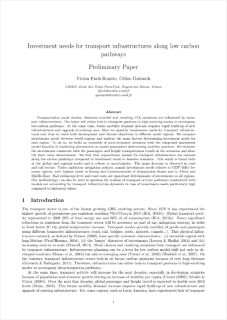
Transportation mode choices, distances traveled and resulting CO2 emissions are influenced by transport infrastructures. The latter will either lock-in transport patterns in high-emitting modes or accompany low-carbon pathways. At the same time, future mobility demand increase requires rapid build-up of new infrastructures and upgrade of existing ones. Here the authors quantify investments needs for transport infrastructures over time to reach both development and climate objectives in different world regions. Investments needs between world regions are compared and the main factors determining investment needs for each region are analyzed. To do so, the authors build an ensemble of socio-economic scenarios with the integrated assessment model Imaclim-R combining alternatives on model parameters determining mobility patterns. The authors estimate the investments consistent with the passengers and freight transportation trends in the scenarios and identify their main determinants. It is found that expenditures needed for transport infrastructure are reduced along low-carbon pathways compared to investment levels in baseline scenarios. This result is found both at the global and regional scales and is robust to uncertainties. The main decrease is observed in road and rail sectors. Under ambitious mitigation policies, annual investment needs relative to GDP differ between regions, with highest needs in Russia and Commonwealth of Independent States and in Africa and the Middle-East. Rail utilization level and road costs are important determinants of investments in all regions. The methodology can also be used to question the realism of transport activity pathways constructed with models not accounting for transport infrastructure dynamics in case of investments needs particularly high compared to historical values.
